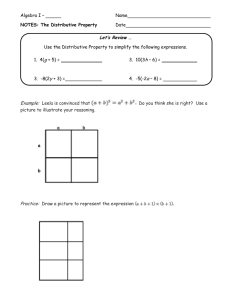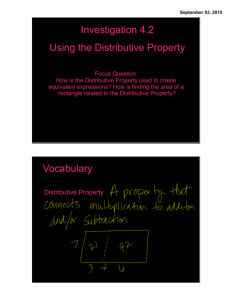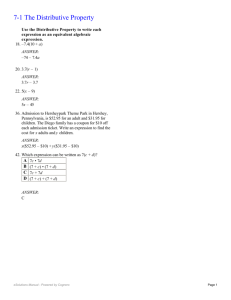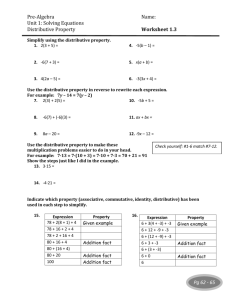δ LATTICES M. Sambasiva Rao
advertisement
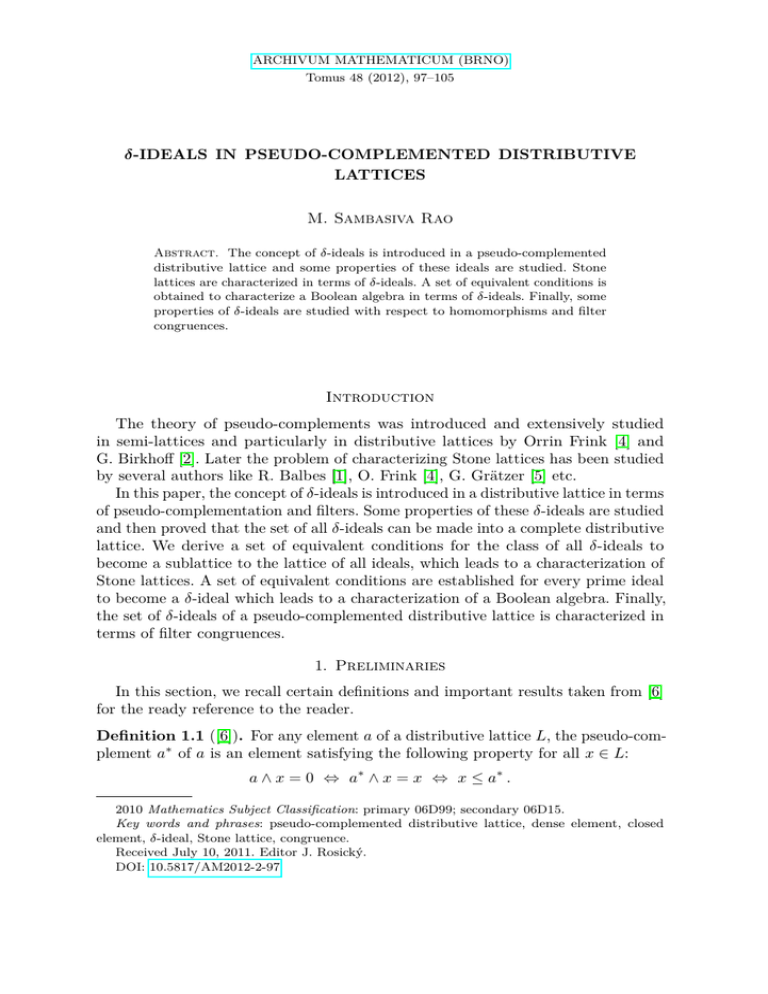
ARCHIVUM MATHEMATICUM (BRNO)
Tomus 48 (2012), 97–105
δ-IDEALS IN PSEUDO-COMPLEMENTED DISTRIBUTIVE
LATTICES
M. Sambasiva Rao
Abstract. The concept of δ-ideals is introduced in a pseudo-complemented
distributive lattice and some properties of these ideals are studied. Stone
lattices are characterized in terms of δ-ideals. A set of equivalent conditions is
obtained to characterize a Boolean algebra in terms of δ-ideals. Finally, some
properties of δ-ideals are studied with respect to homomorphisms and filter
congruences.
Introduction
The theory of pseudo-complements was introduced and extensively studied
in semi-lattices and particularly in distributive lattices by Orrin Frink [4] and
G. Birkhoff [2]. Later the problem of characterizing Stone lattices has been studied
by several authors like R. Balbes [1], O. Frink [4], G. Grätzer [5] etc.
In this paper, the concept of δ-ideals is introduced in a distributive lattice in terms
of pseudo-complementation and filters. Some properties of these δ-ideals are studied
and then proved that the set of all δ-ideals can be made into a complete distributive
lattice. We derive a set of equivalent conditions for the class of all δ-ideals to
become a sublattice to the lattice of all ideals, which leads to a characterization of
Stone lattices. A set of equivalent conditions are established for every prime ideal
to become a δ-ideal which leads to a characterization of a Boolean algebra. Finally,
the set of δ-ideals of a pseudo-complemented distributive lattice is characterized in
terms of filter congruences.
1. Preliminaries
In this section, we recall certain definitions and important results taken from [6]
for the ready reference to the reader.
Definition 1.1 ([6]). For any element a of a distributive lattice L, the pseudo-complement a∗ of a is an element satisfying the following property for all x ∈ L:
a ∧ x = 0 ⇔ a∗ ∧ x = x ⇔ x ≤ a∗ .
2010 Mathematics Subject Classification: primary 06D99; secondary 06D15.
Key words and phrases: pseudo-complemented distributive lattice, dense element, closed
element, δ-ideal, Stone lattice, congruence.
Received July 10, 2011. Editor J. Rosický.
DOI: 10.5817/AM2012-2-97
98
M. SAMBASIVA RAO
A distributive lattice L in which every element has a pseudo-complement is
called a pseudo-complemented distributive lattice. Throughout this paper L stands
for a pseudo-complemented distributive lattice (L, ∨, ∧,∗ , 0, 1).
Theorem 1.2 ([6]). For any two elements a, b of a pseudo-complemented distributive lattice, we have the following:
(1) 0∗∗ = 0,
(2) a ∧ a∗ = 0,
(3) a ≤ b implies b∗ ≤ a∗ ,
(4) a ≤ a∗∗ ,
(5) a∗∗∗ = a∗ ,
(6) (a ∨ b)∗ = a∗ ∧ b∗ ,
(7) (a ∧ b)∗∗ = a∗∗ ∧ b∗∗ .
An element x of a pseudo-complemented lattice L is called dense [6] if x∗ = 0
and the set D(L) of all dense element of L forms a filter of L.
Definition 1.3 ([1]). A pseudo-complemented distributive lattice L is called a
Stone lattice if, for all x ∈ L, it satisfies the property: x∗ ∨ x∗∗ = 1.
Theorem 1.4 ([6]). Let I be an ideal and F a filter of a distributive lattice L such
that I ∩ F = ∅. Then there exists a prime ideal P such that I ⊆ P and P ∩ F = ∅.
A prime ideal P of a distributive lattice L is called a minimal prime ideal [8] if
there exists no prime ideal Q such that Q ⊂ P . A prime ideal P is minimal if and
only if to each x ∈ P there exists y ∈
/ P such that x ∧ y = 0.
2. δ-ideals
In this section, the concept of δ-ideals is introduced in a pseudo-complemented
distributive lattice. Stone lattice and Boolean algebras are characterized in terms
of δ-ideals. Finally, δ-ideals are characterized in terms of congruences.
Definition 2.1. Let L be a pseudo-complemented distributive lattice. Then for
any filter F of L, define the set δ(F ) as follows:
δ(F ) = {x ∈ L | x∗ ∈ F } .
In the following, some basic properties of δ(F ) can be observed.
Lemma 2.2. Let L be a pseudo-complemented distributive lattice. Then for any
filter F of L, δ(F ) is an ideal of L.
Proof. Since 0∗ ∈ F , we get that 0 ∈ δ(F ). Let x, y ∈ δ(F ). Then x∗ , y ∗ ∈ F .
Hence (x ∨ y)∗ = x∗ ∧ y ∗ ∈ F . Again, let x ∈ δ(F ) and r ∈ L. Then x∗ ∈ F . Hence
(x ∧ r)∗ = (x ∧ r)∗∗∗ = (x∗∗ ∧ r∗∗ )∗ = (x∗ ∨ r∗ )∗∗ ∈ F (because x∗ ∨ r∗ ∈ F ). Hence
we get that x ∧ r ∈ δ(F ). Therefore δ(F ) is an ideal in L.
Lemma 2.3. Let L be a pseudo-complemented distributive lattice. For any two
filters F, G of L, we have the following:
δ-IDEALS IN PSEUDO-COMPLEMENTED DISTRIBUTIVE LATTICES
99
(1) F ∩ δ(F ) = ∅,
(2) x ∈ δ(F ) ⇒ x∗∗ ∈ δ(F ),
(3) F = L if and only if δ(F ) = L,
(4) F ⊆ G ⇒ δ(F ) ⊆ δ(G),
(5) δ(F ∩ G) = δ(F ) ∩ δ(G).
Proof. (1) Suppose x ∈ F ∩ δ(F ). Then x ∈ F and x∗ ∈ F . Since F is a filter, we
get 0 = x∗ ∧ x ∈ F , which is a contradiction. Therefore F ∩ δ(F ) = ∅.
(2) Since x∗∗∗ = x∗ , it is clear.
(3) Assume that F = L. Then we have 0∗∗ = 0 ∈ F . Hence 0∗ ∈ δ(F ). Therefore
δ(F ) = L. Converse is an easy reverse of the above.
(4) Suppose F ⊆ G. Let x ∈ δ(F ). Then x∗ ∈ F ⊆ G. Therefore x ∈ δ(G).
(5) Clearly δ(F ∩G) ⊆ δ(F )∩δ(G). Conversely, let x ∈ δ(F )∩δ(G). Then x∗ ∈ F ∩G.
Hence x ∈ δ(F ∩ G). Therefore δ(F ) ∩ δ(G) ⊆ δ(F ∩ G).
The concept of δ-ideals is now introduced in the following.
Definition 2.4. Let L be a pseudo-complemented distributive lattice. An ideal I
of L is called a δ-ideal if I = δ(F ) for some filter F of L.
Example 2.5. Consider the distributive lattice L = {0, a, b, c, 1} whose Hasse
c1
diagram is given in the following figure:
Consider I = {0, a} and F = {b, c, 1}.
Clearly I is an ideal and F a filter of L.
Now δ(F ) = {x | x∗ ∈ F } = {0, a}.
Therefore I is a δ-ideal of L.
But J = {0, a, b, c} is not a δ-ideal of L.
Suppose J = δ(F ) for some filter F
a c
@
@
cc
@
@
@cb
@c
0
Then 0 = c∗ ∈ F . Hence F = L, which yields that J = δ(F ) = L.
The following lemmas produce some more examples for δ-ideals.
Lemma 2.6. For each x ∈ L, (x∗ ] is a δ-ideal of L.
Proof. It is enough to show that (x∗ ] = δ([x)). Let a ∈ (x∗ ]. Then a ∧ x = 0 and
hence a∗ ∧ x = x ∈ [x). Thus a∗ ∈ [x). Therefore a ∈ δ([x)). Conversely, suppose
that a ∈ δ([x)). Then a∗ ∧ x = x and hence a ∧ x = a ∧ a∗ ∧ x = 0. Thus a ∧ x∗ = a,
which yields that a ∈ (x∗ ]. Therefore (x∗ ] is a δ-ideal of L.
Lemma 2.7. Every prime ideal without dense element is a δ-ideal.
Proof. Let P be a prime ideal with out dense element. Let x ∈ P . Then clearly
x ∧ x∗ = 0 and x ∨ x∗ is dense. Hence x ∨ x∗ ∈
/ P . Thus we get x∗ ∈
/ P , which
∗
yields that x ∈ L − P . Thus x ∈ δ(L − P ). Therefore P ⊆ δ(L − P ). Conversely,
let x ∈ δ(L − P ). Then x∗ ∈ L − P , which implies that x∗ ∈
/ P . Hence x ∈ P . Thus
P = δ(L − P ). Therefore P is a δ-ideal of L.
100
M. SAMBASIVA RAO
Corollary 2.8. Every minimal prime ideal is a δ-ideal.
Proof. Let P be a minimal prime ideal of L. Suppose x ∈ P ∩ D(L). Then there
exists y ∈
/ P such that x ∧ y = 0. Hence y ≤ x∗ = 0 ∈ P , which is a contradiction.
Thus P ∩ D(L) = ∅. Therefore, by above lemma, P is a δ-ideal.
In the following, a simple property of δ-ideals is observed.
Lemma 2.9. A proper δ-ideal contains no dense element.
Proof. Let δ(F ) be a proper δ-ideal of L. Suppose x ∈ δ(F ) ∩ D(L). Then we get
0 = x∗ ∈ F , which is a contradiction. Therefore δ(F ) ∩ D(L) = ∅.
δ
Let us denote the set of all δ-ideals of L by I (L). Then by Example 2.5, it
can be observed that I δ (L) is not a sublattice of I(L) of all ideals of L. Consider
F = {b, c, 1} and G = {a, c, 1}. Clearly F and G are filters of L. Now δ(F ) = {0, a}
and δ(G) = {0, b}. But δ(F ) ∨ δ(G) = {0, a, b, c} is not a δ-ideal of L, because
c ∈ δ(F ) ∨ δ(G) is a dense element. However, in the following theorem, we prove
that I δ (L) forms a complete distributive lattice.
Theorem 2.10. Let L be a pseudo-complemented distributive lattice. Then the set
I δ (L) forms a complete distributive lattice on its own.
Proof. For any two filters F, G of L, define two binary operations ∩ and t as
follows:
δ(F ) ∩ δ(G) = δ(F ∩ G) and δ(F ) t δ(G) = δ(F ∨ G) .
It is clear that δ(F ∩ G) is the infimum of δ(F ) and δ(G) in I δ (L). Also δ(F ) t δ(G)
is a δ-ideal of L. Clearly δ(F ), δ(G) ⊆ δ(F ∨G) = δ(F )tδ(G). Let δ(H) be a δ-ideal
of L such that δ(F ) ⊆ δ(H) and δ(G) ⊆ δ(H), where H is a filter of L. Now we
claim that δ(F ∨ G) ⊆ δ(H). Let x ∈ δ(F ∨ G). Then x∗ ∈ F ∨ G. Hence x∗ = f ∧ g
for some f ∈ F and g ∈ G. Since f ∈ F and g ∈ G, we can get f ∗ ∈ δ(F ) ⊆ δ(H)
and g ∗ ∈ δ(G) ⊆ δ(H). Now
f ∗ ∈ δ(H), g ∗ ∈ δ(H)
⇒ f ∗ ∨ g ∗ ∈ δ(H)
⇒ (f ∗ ∨ g ∗ )∗∗ ∈ δ(H)
⇒ (f ∗∗ ∧ g ∗∗ )∗ ∈ δ(H)
⇒ x∗∗ ∈ δ(H)
⇒ x ∈ δ(H)
δ
Hence δ(F
) t δ(G) = δ(F
∨ G) is the supremum of both δ(F ) and δ(G) in I (L).
δ
Therefore I (L), ∩, t is a lattice. Distributivity of δ-ideals can be easily followed
by using the above operations of I δ (L).
It is clear that I δ (L) is a partially ordered set with respect to set-inclusion.
Then by the extension of the property of Lemma 2.3(5), we can obtain that I δ (L)
is a complete lattice. Therefore I δ (L) is a complete distributive lattice.
∗
From Lemma 2.6, we have already observed that each (x ](for x ∈ L) is a δ-ideal
of L. Now let us denote that A∗ (L) = {(x∗ ] | x ∈ L}. Then, in the following
theorem, it is proved that A∗ (L) is a Boolean algebra.
δ-IDEALS IN PSEUDO-COMPLEMENTED DISTRIBUTIVE LATTICES
101
Theorem 2.11. For any pseudo-complemented distributive lattice L, A∗ (L) is a
sublattice of the lattice I δ (L) of all δ-ideals of L and hence is a Boolean algebra.
Moreover, the mapping x 7−→ (x∗ ] is a dual homomorphism from L onto A∗ (L).
Proof. Let (x∗ ], (y ∗ ] ∈ A∗ (L) for some x, y ∈ L. Then clearly (x∗ ] ∩ (y ∗ ] ∈ A∗ (L).
Again, (x∗ ] t (y ∗ ] = δ([x)) t δ([y)) = δ([x) ∨ [y)) = δ([x ∧ y)) = ((x ∧ y)∗ ] ∈ A∗ (L).
Hence A∗ (L) is a sublattice of I δ (L) and hence a distributive lattice. Clearly
(0∗∗ ] and (0∗ ] are the least and greatest elements of A∗ (L). Now for any x ∈ L,
(x∗ ] ∩ (x∗∗ ] = (0] and (x∗ ] t (x∗∗ ] = δ([x)) t δ([x∗ )) = δ([x) ∨ [x∗ )) = δ([x ∧
x∗ )) = δ([0)) = δ(L) = L. Hence (x∗∗ ] is the complement of (x∗ ] in A∗ (L).
Therefore hA∗ (L), t, ∩i is a bounded distributive lattice in which every element is
complemented. The remaining part can be easily observed.
δ
It was already observed that I (L) is not a sublattice of the ideal lattice I(L).
However, we establish some equivalent conditions for I δ (L) to become a sublattice
of I(L), which leads to a characterization of Stone lattices. For this, we need the
following lemma.
Lemma 2.12. Every proper δ-ideal is contained in a minimal prime ideal.
Proof. Let I be a proper δ-ideal of L. Then I = δ(F ) for some filter F of L. Clearly
δ(F ) ∩ D(L) = ∅. Then there exists a prime ideal P of L such that δ(F ) ⊆ P and
P ∩ D(L) = ∅. Let x ∈ P . We have always x ∧ x∗ = 0. Suppose x∗ ∈ P . Then
x ∨ x∗ ∈ P ∩ D(L), which is a contradiction. Thus P is a minimal prime ideal of
L.
Since the minimal prime ideals are precisely the complements of maximal filter
of L, the following corollary is a direct consequence.
Corollary 2.13. The minimal prime ideals of a pseudo-complemented distributive
lattice L are maximal elements of the complete lattice I δ (L).
We now characterize Stone lattices in terms of δ-ideals.
Theorem 2.14. Let L be a pseudo-complemented distributive lattice. Then the
following are equivalent:
(1) L is a Stone lattice,
(2) For any x, y ∈ L, (x ∧ y)∗ = x∗ ∨ y ∗ ,
(3) For any two filters F, G of L, δ(F ) ∨ δ(G) = δ(F ∨ G),
(4) I δ (L) is a sublattice of I(L).
Proof. (1) ⇒ (2): It is obtained in Lemma 3 of [6] pp.113.
(2) ⇒ (3): Assume the condition (2). Let F, G be two filters of L. We have always
δ(F ) ∨ δ(G) ⊆ δ(F ∨ G). Conversely, let x ∈ δ(F ∨ G). Then
x∗ ∈ F ∨ G ⇒ x∗ = f ∧ g
for some
⇒x
∗∗
= (f ∧ g)
⇒x
∗∗
= f ∗ ∨ g∗
f ∈ F, g ∈ G
∗
⇒ x∗∗ = f ∗ ∨ g ∗ ∈ δ(F ) ∨ δ(G) since f ∗∗ ∈ F, g ∗∗ ∈ G
⇒ x ∈ δ(F ) ∨ δ(G) .
102
M. SAMBASIVA RAO
Hence δ(F ∨ G) ⊆ δ(F ) ∨ δ(G). Therefore δ(F ) ∨ δ(G) = δ(F ∨ G).
(3) ⇒ (4): It is obvious.
(4) ⇒ (1): Assume that I δ (L) is a sublattice of I(L). Let x ∈ L. By Lemma 2.6,
(x∗ ] and (x∗∗ ] are both δ-ideals of L. Suppose x∗ ∨ x∗∗ 6= 1. Then by condition (4),
(x∗ ] ∨ (x∗∗ ] is a proper δ-ideal of L. Hence there exists a minimal prime ideal P
such that (x∗ ] ∨ (x∗∗ ] ⊆ P . Since P is minimal, we get that x∗∗ ∈
/ P , which is a
contradiction. Therefore L is a Stone lattice.
In the following theorem, a set of equivalent conditions are obtained for every
prime ideal of L to become a δ-ideal which in turn leads to establish some equivalent
conditions for a pseudo-complemented distributive lattice to become a Boolean
algebra. Let us recall that an element x is called closed [6] if x∗∗ = x.
Theorem 2.15. Let L be a pseudo-complemented distributive lattice. Then the
following conditions are equivalent:
(1) L is a Boolean algebra,
(2) Every element of L is closed,
(3) Every principal ideal is a δ-ideal,
(4) For any ideal I, x ∈ I implies x∗∗ ∈ I,
(5) For any proper ideal I, I ∩ D(L) = ∅,
(6) For any prime ideal P , P ∩ D(L) = ∅,
(7) Every prime ideal is a minimal prime ideal,
(8) Every prime ideal is a δ-ideal,
(9) For any x, y ∈ L, x∗ = y ∗ implies x = y,
(10) D(L) is a singleton set.
Proof. (1) ⇒ (2): Assume that L is a Boolean algebra. Then clearly L has a unique
dense element, precisely the greatest element. Let x ∈ L. Then x∗ ∧x = 0 = x∗ ∧x∗∗ .
Also x∗ ∨ x, x∗ ∨ x∗∗ ∈ D(L). Hence x∗ ∨ x = x∗ ∨ x∗∗ . By the cancelation property
of L, we get x = x∗∗ . Therefore every element of L is closed.
(2) ⇒ (3): Let I be a principal ideal of L. Then I = (x] for some x ∈ L. Then by
condition (2), x = x∗∗ . Now, (x] = (x∗∗ ] = δ([x∗ )). Therefore (x] is a δ-ideal.
(3) ⇒ (4): Let I be a proper ideal of L. Let x ∈ I. Then (x] = δ(F ) for some filter
F of L. Hence we get x∗∗∗ = x∗ ∈ F . Therefore x∗∗ ∈ δ(F ) = (x] ⊆ I.
(4) ⇒ (5): Let I be a proper ideal of L. Suppose x ∈ I ∩ D(L). Then x∗∗ ∈ I and
x∗ = 0. Therefore 1 = 0∗ = x∗∗ ∈ I, which is a contradiction.
(5) ⇒ (6): It is clear.
(6) ⇒ (7): Let P be a prime ideal of L such that P ∩ D(L) = ∅. Let x ∈ P . Then
clearly x ∧ x∗ = 0 and x ∨ x∗ ∈ D(L). Hence x ∨ x∗ ∈
/ P . Thus x∗ ∈
/ P . Therefore
P is a minimal prime ideal of L.
(7) ⇒ (8): Let P be a minimal prime ideal of L. Then clearly L − P is a filter of
L. Let x ∈ P . Since P is minimal, there exists y ∈
/ P such that x ∧ y = 0. Hence
x∗ ∧ y = y, which implies that x∗ ∈
/ P . Thus x∗ ∈ L − P , which yields x ∈ δ(L − P ).
Conversely, let x ∈ δ(L − P ). Then we get x∗ ∈
/ P . Hence we have x ∈ P . Thus
δ-IDEALS IN PSEUDO-COMPLEMENTED DISTRIBUTIVE LATTICES
103
P = δ(L − P ) and therefore P is a δ-ideal of L.
(8) ⇒ (9): Assume that every prime ideal of L is a δ-ideal. Let x, y ∈ L be such
that x∗ = y ∗ . Suppose x 6= y. Then there exists a prime ideal P of L such that
x ∈ P and y ∈
/ P . By hypothesis, P is a δ-ideal of L. Hence P = δ(F ) for some
filter F of L. Since x ∈ P = δ(F ), we get y ∗ = x∗ ∈ F . Hence y ∈ δ(F ) = P , which
is a contradiction. Therefore x = y.
(9) ⇒ (10): Suppose a, b be two elements of D(L). Then a∗ = 0 = b∗ . Hence a = b.
Therefore D(L) is a singleton set.
(10) ⇒ (1): Assume that D(L) = {d} is a singleton set. Let x ∈ L. We have always
x ∨ x∗ ∈ D(L). Therefore x ∧ x∗ = 0 and x ∨ x∗ = d. This true for all x ∈ L. Also
0 ≤ x ≤ x ∨ x∗ = d. Therefore L is a bounded distributive lattice in which every
element is complemented.
We now prove that the homomorphic image of a δ-ideal is again a δ-ideal. By a
homomorphism [6] on a bounded lattice, we mean a homomorphism which preserves
0 and 1. We now start our observation with the following fact.
Unlike in rings, if an onto homomorphism of a distributive lattice L into another
lattice L0 such that ker f = {x ∈ L | f (x) = 0} = {0}, then f need not be an
isomorphism. For this, we consider two chains L = {0, a, 1} and L0 = {00 , 10 }. Now,
define a mapping f : L −→ L0 by f (0) = 00 and f (a) = f (1) = 10 . Then clearly f is
a homomorphism from L into L0 and also f is onto. Also Ker f = {0}. But f is
not one-one. Hence f is not an isomorphism.
Lemma 2.16. Let L and L0 be two pseudo-complemented distributive lattices with
pseudo-complementation ∗ and f : L −→ L0 an onto homomorphism. If Ker f =
{0}, then f (x∗ ) = {f (x)}∗ for all x ∈ L.
Proof. We have always f (x)∧f (x∗ ) = f (x∧x∗ ) = f (0) = 0. Suppose f (x)∧f (t) =
0 for some t ∈ L. Then f (x ∧ t) = 0 and hence x ∧ t ∈ ker f = {0}. Thus x ∧ t = 0.
Hence x∗ ∧ t = t, which yields f (x∗ ) ∧ f (t) = f (x∗ ∧ t) = f (t). Therefore f (x∗ ) is
the pseudo-complement of f (x) in L0 .
In the following, we prove that the image of a δ-ideal of L under the above
homomorphism is again a δ-ideal.
Theorem 2.17. Let L, L0 be two pseudo-complemented distributive lattices with
pseudo-complementation ∗ and f : L −→ L0 an onto homomorphism such that
Ker f = {0}. If I is a δ-ideal of L, then f (I) is a δ-ideal of L0 .
Proof. Let I be a δ-ideal of L. Then I = δ(G) for some filter G of L. Since the
homomorphism f preserves 1, we can get that f (G) is a filter in L0 . Now, it is
enough to show that f {δ(G)} = δ{f (G)}. Let a ∈ f {δ(G)}. Then a = f (x) for
some x ∈ δ(G). Hence x∗ ∈ G. Now f (x) ∧ f (x∗ ) = f (x ∧ x∗ ) = f (0) = 0. Hence
{f (x)}∗ ∧ f (x∗ ) = f (x∗ ) ∈ f (G). Thus {f (x)}∗ ∈ f (G). Therefore a = f (x) ∈
δ{f (G)}. Therefore f {δ(G)} ⊆ δ{f (G)}. Conversely, let y ∈ δ{f (G)}. Since f
is on-to, there exists x ∈ L such that y = f (x). Then {f (x)}∗ ∈ f (G). Hence
104
M. SAMBASIVA RAO
{f (x)}∗ = f (a) for some a ∈ G. Now
f (x) ∧ {f (x)}∗ = 0 ⇒ f (x) ∧ f (a) = 0
⇒ f (x ∧ a) = 0
⇒ x ∧ a ∈ Ker f = {0}
⇒ x∗ ∧ a = a ∈ G
⇒ x∗ ∈ G
⇒ x ∈ δ(G)
⇒ y = f (x) ∈ f {δ(G)} .
Thus δ{f (G)} ⊆ f {δ(G)}. Therefore δ{f (G)} = f {δ(G)}.
We now characterize δ-ideals in terms of congruences. For this, we consider a
well known filter congruence introduced by T. P. Speed [7].
Theorem 2.18 ([7]). For any filter F of L, define a relation θ(F ) as follows:
(a, b) ∈ θ(F ) ⇔ a ∧ f = b ∧ f
for some
f ∈F.
Then θ(F ) is a congruence relation on L.
Lemma 2.19. Let L be a pseudo-complemented distributive lattice. Then for any
ideal I of L, FI = {x ∈ L | x∗ ∧ a∗ = 0 for some a ∈ I} is a filter of L.
Proof. Clearly 0∗ ∈ FI . Let x, y ∈ FI . Then x∗ ∧ a∗ = 0 and y ∗ ∧ b∗ = 0 for
some a, b ∈ I. Hence x∗∗ ∧ a∗ = a∗ and y ∗∗ ∧ b∗ = b∗ . Now (x ∧ y)∗∗ ∧ (a ∨ b)∗ =
x∗∗ ∧y ∗∗ ∧a∗ ∧b∗ = a∗ ∧b∗ . Thus (x∧y)∗ ∧(a∨b)∗ = 0. Therefore x∧y ∈ FI . Again, let
x ∈ FI and s ∈ L. Then x∗ ∧ a∗ = 0 for some a ∈ I. Now (x ∨ s)∗ ∧ a∗ ≤ x∗ ∧ a∗ = 0.
Thus x ∨ s ∈ FI . Therefore FI is a filter of L.
Theorem 2.20. For any ideal I of a pseudo-complemented distributive lattice L,
the following conditions are equivalent:
(1) I is a δ-ideal,
(2) I = Ker θ(FI ),
(3) I = Ker θ(F ) for some filter F of L.
Proof. (1) ⇒ (2): Assume that I is a δ-ideal of L. Then I = δ(F ) for some filter
F of L. Let x ∈ I. Since x∗∗ ∧ x∗ = 0, we can get x∗ ∈ FI . Since x ∧ x∗ = 0
and x∗ ∈ FI , we thus get x ∈ Ker θ(FI ). Therefore I ⊆ Ker θ(FI ). Conversely, let
x ∈ Ker θ(FI ). Then (x, 0) ∈ θ(FI ). Thus x ∧ f = 0 for some f ∈ FI . Since f ∈ FI ,
we get that f ∗ ∧ a∗ = 0 for some a ∈ I. Hence x ≤ f ∗ ≤ a∗∗ ∈ δ(F ) = I. Therefore
I = Ker θ(FI ).
(2) ⇒ (3): It is clear.
(3) ⇒)1): Assume that I = Ker θ(F ) for some filter F of L. Let x ∈ I = Ker θ(F ).
Then x ∧ f = 0 for some f ∈ F . Hence x∗ ∧ f = f ∈ F . Thus x∗ ∈ F , which yields
that x ∈ δ(F ). Therefore I ⊆ δ(F ). Conversely, let x ∈ δ(F ). Then x∗ ∈ F . Since
x ∧ x∗ = 0 and x∗ ∈ F , we get (x, 0) ∈ θ(F ). Thus x ∈ Ker θ(F ) = I. Therefore I
is a δ-ideal of L.
δ-IDEALS IN PSEUDO-COMPLEMENTED DISTRIBUTIVE LATTICES
105
Acknowledgement. The author is grateful to the referee for his valuable comments and suggestions for the improvement of the paper.
References
[1] Balbes, R., Horn, A., Stone lattices, Duke Math. J. 37 (1970), 537–545.
[2] Birkhoff, G., Lattice Theory, Colloquium Publications, vol. 25, Amer. Math. Soc., New York,
1948.
[3] Cornish, W. H., Congruences on distributive pseudocomplemented lattices, Bull. Austral. Math.
Soc. 8 (1973), 161–179.
[4] Frink, O., Pseudo-complements in semi-lattices, Duke Math. J. 29 (1962), 505–514.
[5] Grätzer, G., A generalization on Stone’s representation theorem for Boolean algebras, Duke
Math. J. 30 (1963), 469–474.
[6] Grätzer, G., General lattice theory, Academic Press, New York, San Francisco, 1978.
[7] Speed, T. P., Two congruences on distributive lattices, Bull. Soc. Roy. Sci. Liège 38 (3–4)
(1969), 86–95.
[8] Speed, T. P., Spaces of ideals of distributive lattices II. Minimal prime ideals, J. Austral.
Math. Soc. 18 (1974), 54–72.
Department of Mathematics,
MVGR College of Engineering, Chintalavalasa,
Vizianagaram, Andhra Pradesh, India-535005
E-mail: mssraomaths35@rediffmail.com
